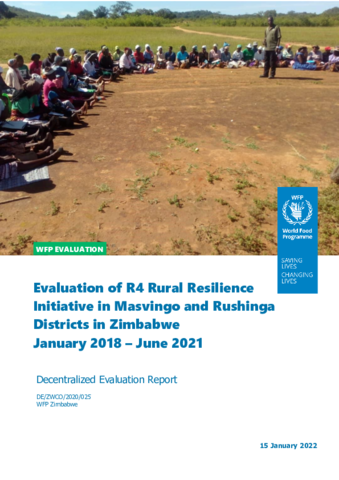
The key objective of this evaluation was to produce new evidence for operational and strategic decision-making to inform the second phase of the R4 rural resilience initiative and the Zimbabwe Country office’s approach to resilience building programming to be adopted in the 2021-2025 Country Strategic Plan. The evaluation also intended to reduce existing evidence gaps in the studies on the R4 Initiative in Zimbabwe conducted prior to the final evaluation, mainly related to the integrated risk management (IRM) approach and integration of R4 activities with each other and with other WFP activities in Zimbabwe. The evaluation served the dual purpose of learning and accountability (with more weight given to learning). It focused on assessing the relevance, effectiveness, efficiency, impact, and sustainability of the R4 initiative. The overarching evaluation question focused on the extent to which the R4 initiative, as part of the integrated risk management interventions, was effective in enhancing food security and building the resilience of beneficiary households and communities.
Some of the key evaluation findings included:
- Women's needs and situations were addressed via a thorough and participatory planning process (for example, in terms of facilitating their participation and saving them labour). Village Savings and Loan (VSL) clubs help a vast unbanked population save and borrow.
- R4 actions aligns with WFP mission and government policy on food security and resilience. The enterprise was also able to respond to new economic issues by increasing insurance pay-outs to combat inflation.
- R4 appears to have increased household income and income diversification (or at least safeguarded income levels and diversification from shocks), as well as crop variety.
- Due to a fully funded project budget, input delivery delays were maintained to a minimal, and expenditures per beneficiary for Food Assistance for Assets (FFA) measures were competitive with comparable agricultural interventions in Zimbabwe.
- Young people’s involvement is disproportionately concentrated in the work on constructing assets, with much lower levels of participation in the agricultural training sessions and VSLs.
- Beneficiaries – in particular women – experienced an improvement in Food Consumption, Dietary Diversity Scores and resilience over the course of the programme.
- Enabling clients to receive Lean Season Assistance likely reduced the loss of household assets during bad harvest years.
- The initiative did not transform gender dynamics structurally, but rather contributed to a longer-term reform process.
- Budget and capacity constraints make it unlikely that the government will take up R4 in its current form. If farmers have access to inputs and machinery, conservation agriculture assets will continue to function if management committees exist.
- Farmers like being insured but the majority are unlikely to purchase insurance from their own pocket under current arrangements. There is a strong preference to continue to ‘purchase’ insurance through FFA.
Key recommendations from the evaluation included:
- Investigate the relative utility and sustainability of ‘community built / individually owned’ and ‘community built / community owned’ assets.
- Ensure that successes in mechanized conservation agriculture are widely communicated and form the foundation for advocating Government support in this area.
- Strive to provide better opportunities for more young people to participate in the programme.
- Continue to ‘prime the pump’ for reliable supply of appropriate equipment and inputs through the provision of smart subsidies.
- Building resilience takes time and will include providing support through a variety of actions including LSA (where necessary) and R4 over a period of several years (minimum of five years’ engagement).
- Encourage smallholders’ uptake of crop insurance through a range of actions including communication, management, and advocacy.
- Explore the validity of assumptions relating to micro credit which underpin the R4 Theory of Change.
- Strive to ensure smallholder productivity is given the budgetary priority required.
